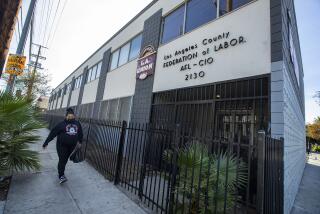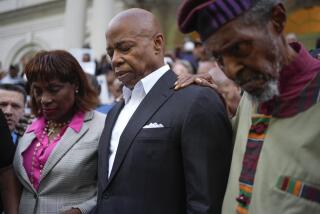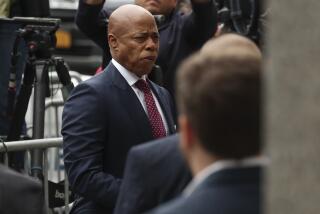N.Y. Corruption Cases Breeding New Cynicism
NEW YORK â During his trial on bribery and corruption charges, Meade H. Esposito, the brash, tough-talking former leader of the Brooklyn Democratic organization, boasted on a secret federal wiretap how he viewed his mandate.
âI was boss of the (expletive deleted) state,â the 80-year-old Esposito bragged, adding on another tape: âI can open doors. This is my forte.â
In New York, where for the last 20 months corruption trials and investigations of public officials have dominated the headlines, the perception has grown that almost anything is possible for those with money and political clout.
More Than 25 Implicated
Revelations of impropriety have reached deep within City Hall and to the core of the Brooklyn, Bronx and Queens Democratic parties. So far, more than 25 officials--including judges, commissioners, county leaders, state senators and assemblymen--either have been indicted, come under investigation or have been forced to resign. Last week, New York state Senate Minority Leader Manfred Ohrenstein, a top aide and another state senator were indicted on charges of using public funds for a political campaign.
So many public figures have come under scrutiny that some newspapers print score cards. Along with allegations of widespread political corruption have come a series of spectacular Mafia trials and multiple investigations of organized crimeâs influence in the construction industry. Some state officials believe the mob dominates large segments of the building business, that mob collusion with contractors and corrupt union officials is common.
Despite a string of well-publicized cases, prosecutors and FBI officials stop short of saying that governmental corruption is epidemic or that organized crime has succeeded in subverting the political process.
Ronald Goldstock, director of the New York state Organized Crime Task Force, described what has been uncovered as âpieces of corruption.â
âThe cases that we brought do not show systematic corruption of the type that was found in the 1920s,â said a top FBI official supervising investigations in New York, who asked not to be identified. âThey are not corrupting the system. Since the 1950s, organized crime does not have that kind of hold. Now we find pockets of corruption.â
Scenes of High Drama
Nevertheless, there have been scenes of high drama. Queens Borough President Donald Manes committed suicide by plunging a kitchen knife through his heart last year while facing possible indictment for taking payoffs. Former Democratic vice presidential candidate Geraldine A. Ferraro pledged emotionally that she would stand by her embattled husband, realtor John A. Zaccaro, who is scheduled to go to trial later this month on charges of bribery and attempted extortion in a scandal involving cable television franchises. Ohrenstein, surrounded by detectives, was booked in handcuffs when he surrendered to face the allegations against him.
One danger, some public officials believe, may be pervasive pessimism about the political process.
John D. Feerick, chairman of the New York State Commission on Government Integrity, warned of a climate of âcorrosive cynicism about government.â
âThe last several years may be remembered as the most scandal plagued in the history of New York state,â Feerick said.
Mayor on Defensive
None of the allegations personally involve Mayor Edward I. Koch, though he clearly has been put on the defensive--particularly by the forced resignation of Cultural Affairs Commissioner Bess Myerson, his close friend. The former Miss America resigned after an investigatorâs report commissioned by the mayor concluded that she schemed improperly to lower the alimony of her regular companion, contractor Carl Capasso, a much younger man.
The scandals have taken their toll on Koch in other ways.
Speaking of the strain he has been under, the mayor said the âtraumaâ of the corruption investigations may have contributed to a minor stroke he suffered in August.
âTrouble begins when party officials are given patronage power over particular agencies,â Goldstock said. âPatronage power corrupts as much as any other kind of power. . . . Any time a party leader is given patronage control over an agency, you have trouble because there is the potential of corrupting the agency for the leaderâs personal profit.â
Lesson for Officials
Another lesson for public officials, Goldstock contended, lies in the sociology of the city. âIn many cases, because of the geophysical characteristics, historical influences and political structure, the structural dynamics in New York are particularly inviting for corruption,â he said.
âAdded to that, there is a profound Cosa Nostra presence, which is in a position to take advantage of those opportunities. So problems tend to be exacerbated. If the same kind of opportunity exists in Iowa and there is no organized crime group to take advantage of it, you are not likely to have the corruption and racketeering that goes with it.â
New Yorkâs scandals erupted publicly when Manes was found near death, dazed and bleeding in his car near Shea Stadium in January, 1986. At first the Queens borough president, one of the cityâs most powerful politicians, said he was attacked and kidnaped by two men who were hiding in the back seat. Later, from his hospital bed, he confessed he had tried to commit suicide. Manes succeeded several weeks later.
Con Man an Informant
Tips to investigators have come from a number of sources, including Michael Raymond, a con man working undercover for the FBI, who helped focus attention on scandals in New Yorkâs Parking Violations Bureau.
Other information pointing to some of New Yorkâs top politicians began to surface as early as December, 1984, with a single wiretap monitored by the Union County Prosecutorâs Office on an allegedly Mafia-run sports gambling operation in Long Branch, N.J.
When local detectives began hearing Mafia figures mentioning names of at least two prominent New York politicians, the FBI was called in and it became a joint investigation. Some of the monitored discussions touched on schemes for mob control of minority contractors. Specific building projects in Manhattan were mentioned.
Unforeseen Complications
As the investigation gained momentum, FBI agents specializing in corruption ran into some unforeseen complications. Wiretaps revealed that the subject of a federal inquiry discussed using a high official of the Patrolmenâs Benevolent Assn.--New Yorkâs police union--to check the license plates of FBI surveillance vehicles, according to court documents. There were further fears that one sensitive FBI wiretap affidavit, which was sealed by a federal judge, had been leaked to a member of the Genovese organized crime family, who was under investigation.
When the wiretap suddenly went dead, law enforcement officials became suspicious. Investigators eventually found the organized crime figure somehow had obtained a copy of the affidavit.
As scrutiny of corruption in New York continues, a major problem remains the correlation of information. Prosecutors say many months of electronic surveillance remain to be analyzed and numerous leads need to be followed.
Wiretap Spawns Others
The scope of the task can be seen from the original New Jersey wiretap, which quickly spawned others, tying up large numbers of agents. Investigators say it takes as many as 30 people to monitor and transcribe a single 24-hour wiretap. At one point in 1985, at least a dozen wiretaps in New York and New Jersey were in operation.
In the New Jersey investigation over a 13-month period, 60,000 conversations were recorded. Pertinent wiretap transcripts stand over six feet high.
Other wiretap evidence has provided the spine of the governmentâs case against Esposito, who is being tried in Brooklyn federal court with Bronx Congressman Mario Biaggi.
Esposito was accused of paying for the expenses of Biaggi and a woman companion at a Florida spa over the Christmas and New Year holidays of 1984-85 in return for Biaggiâs help in trying to get the Navy to speed funds to a ship repair company based in the Brooklyn Navy Yard and to persuade city officials to reduce the companyâs utility bill. The defunct company, Coastal Dry Dock & Repair Corp., was a major client of Espositoâs insurance brokerage business.
Reputation for Toughness
Biaggi, who capitalized on his reputation as a tough cop to be elected to Congress in 1968, also was charged with obstructing justice for allegedly coaching Esposito to cover up the trips.
Barry Slotnick, Biaggiâs lawyer, said the congressmanâs net worth is over $2 million and he had accepted the gift from Esposito as a gesture to an old friend and not as a bribe. He said Biaggi could easily afford to travel the world without Espositoâs help.
Slotnick told the jury that Esposito is a powerful political figure with many contacts.
âMr. Esposito is a telephone person,â Slotnick said. âHe talks to lots of people during the day. He gets calls from the mayor, city councilmen, political people calling. They call for help, advice.â
Interest in One Caller
Federal officials in a separate investigation have shown particular interest in one telephone caller to Esposito. He is Frederico (Fritzy) Giovanelli, 55, who allegedly runs a major gambling operation in New York City and has been identified by the FBI as a high-ranking member of the Genovese organized crime family.
According to court records of wiretaps, Giovanelli and Esposito conversed socially a number of times, visited together and discussed business matters.
Giovanelli and two other defendants are accused of the brutal sidewalk murder of Detective Anthony J. Venditti in January, 1985, outside a Queens diner. Venditti and his partner, Detective Kathleen Burke, were assigned to a joint FBI-New York City Police Department Organized Crime Task Force investigating Genovese family activities.
Meanwhile, the indictment of the minority leader of the New York state Senate added another prominent name to the list of powerful politicians caught up in the corruption scandal. Ohrenstein, state Sen. Howard E. Babush, a Brooklyn Democrat, and Ohrensteinâs chief aide, Frank Sanzillo, all pleaded not guilty to stealing hundreds of thousands of dollars from New York state to finance election campaigns.
Judge Sent to Jail
Earlier this month, Francis X. Smith, once the most powerful judge in Queens, was sentenced to a year in jail for perjury before a grand jury investigating cable television contracts. In March, Stanley Friedman, the former Bronx Democratic boss and a former deputy mayor in the administration of Mayor Abraham D. Beame, was sentenced to a dozen years in prison after being convicted of conspiracy, racketeering and mail fraud in connection with the Parking Violations Bureau.
Former municipal commissioners sentenced to prison for a variety of crimes include the chief officers of the Parking Violations Bureau, the Transportation Commission, the Taxi and Limousine Commission and the Health and Hospitals Corp. A half dozen other key officials have resigned under pressure. Others remain under scrutiny, including Harrison Goldin, the cityâs comptroller, who is being investigated by the cityâs Department of Investigations for contacting investors on behalf of convicted inside trader Ivan Boesky.
And Patrick McGinley, the former investigations commissioner, resigned after questions were raised about the disability claim of a city worker who was injured installing an air conditioner in McGinleyâs home.
More to Read
Sign up for Essential California
The most important California stories and recommendations in your inbox every morning.
You may occasionally receive promotional content from the Los Angeles Times.










